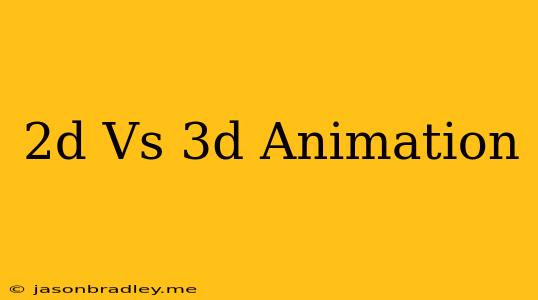2D vs 3D Animation: A Detailed Comparison
Animation is a powerful tool for storytelling, entertainment, and communication. It can bring characters and objects to life, create fantastical worlds, and convey complex ideas in engaging ways.
With the rise of computer technology, there are now two main forms of animation: 2D animation and 3D animation. Both have their own unique strengths and weaknesses, making them suitable for different applications.
2D Animation
2D animation is a traditional form of animation where images are drawn on separate sheets of paper or digitally created as layers. These images are then filmed or captured frame by frame, creating the illusion of movement.
Here are some key characteristics of 2D animation:
- Style: Typically characterized by its flat, two-dimensional style.
- Cost: Relatively inexpensive to produce, especially for simple projects.
- Production time: Generally faster to create than 3D animation.
- Flexibility: Highly flexible in terms of artistic style and expression.
- Examples: Cartoons, anime, video games, explainer videos.
Benefits of 2D animation:
- Simplified and stylized visuals: Ideal for creating unique and memorable characters.
- Faster production: Allows for quicker turnaround times.
- Lower cost: Makes it accessible for smaller budgets.
Limitations of 2D animation:
- Limited realism: Doesn't provide the same level of realism as 3D animation.
- Less detailed backgrounds: Often uses simpler backgrounds to maintain focus on characters.
- Less complex movement: Can't replicate the complex movement and physics of real life.
3D Animation
3D animation uses computer software to create three-dimensional models that are animated using various techniques. This allows for more realistic and complex animation than 2D.
Here are some key characteristics of 3D animation:
- Style: Offers a high degree of realism and detail.
- Cost: More expensive to produce than 2D animation due to the complex software and techniques involved.
- Production time: Generally longer than 2D animation.
- Flexibility: Less flexible in terms of artistic style compared to 2D animation.
- Examples: Films, video games, commercials, architectural visualizations.
Benefits of 3D animation:
- High level of realism: Offers a greater sense of depth and immersion.
- Complex movement and physics: Can accurately simulate real-world physics.
- Detailed and immersive environments: Allows for intricate and realistic environments.
Limitations of 3D animation:
- High production cost: Can be expensive to produce, especially for large projects.
- Time-consuming process: Requires significant time and effort to create.
- Less artistic flexibility: Limited in terms of style compared to 2D animation.
Conclusion
Ultimately, the choice between 2D and 3D animation depends on the specific project's needs and goals.
2D animation is a great option for projects that require a stylized look, fast production times, and a lower budget.
3D animation is ideal for projects that demand realism, complex movement, and immersive environments.
By understanding the strengths and limitations of each form, you can make the best decision for your animation project.
